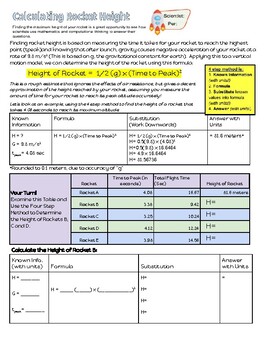When the rocket achieved the apogee and the phone is motionless for a couple of seconds, the app will lock the measured angle. B. For example, the greater the thrust/the less the original weight of the rocket, the more weight or mass must be added to the rocket to insure maximum apogee. Determine the maximum height reached by the rocket and the time needed to reach this height. [Maxheight, timeindex] = max (y); Now timeindex tells you which entry in y was maximum, and you can use that index to figure out what the corresponding time was. With that being said, we can use the equation, #v_y# is the velocity at a certain height #h#, #v_(0y)# is the initial velocity, given as #800# #"m/s"#, #g# is the acceleration due to gravity near earth's surface,#9.81# #"m/s"#, At its maximum height, the instantaneous velocity #v_y# is #0#, so we have, #0 = (800color(white)(l)"m/s")^2 - 2(9.81color(white)(l)"m/s"^2)h#, #h = ((800color(white)(l)"m/s")^2)/(2(9.81color(white)(l)"m/s"^2)) = color(red)(3.26xx10^4# #color(red)("m"#, #KE=3,744,0000=3.744*10^7#(standard form so that we are less prone to errors occurring), g= gravitational strength (for Earth 10N/kg), 4743 views Other MathWorks country So, just measure E, d, and and plug them into the formula above to find out how high your rocket went. The calculator will calculate the maximum altitude assuming that the rocket was flying perfectly vertically.  The equation for the distance traveled by a projectile being affected by gravity is sin(2)v2/g, where is the angle, v is the initial velocity and g is acceleration due to gravity. WebThe Formula for Maximum Height. How to use bearer token to authenticate with Tridion Sites 9.6 WCF Coreservice, SSD has SMART test PASSED but fails self-testing. window.jQuery || document.write('
The equation for the distance traveled by a projectile being affected by gravity is sin(2)v2/g, where is the angle, v is the initial velocity and g is acceleration due to gravity. WebThe Formula for Maximum Height. How to use bearer token to authenticate with Tridion Sites 9.6 WCF Coreservice, SSD has SMART test PASSED but fails self-testing. window.jQuery || document.write('
 The equation for the distance traveled by a projectile being affected by gravity is sin(2)v2/g, where is the angle, v is the initial velocity and g is acceleration due to gravity. WebThe Formula for Maximum Height. How to use bearer token to authenticate with Tridion Sites 9.6 WCF Coreservice, SSD has SMART test PASSED but fails self-testing. window.jQuery || document.write('
The equation for the distance traveled by a projectile being affected by gravity is sin(2)v2/g, where is the angle, v is the initial velocity and g is acceleration due to gravity. WebThe Formula for Maximum Height. How to use bearer token to authenticate with Tridion Sites 9.6 WCF Coreservice, SSD has SMART test PASSED but fails self-testing. window.jQuery || document.write('